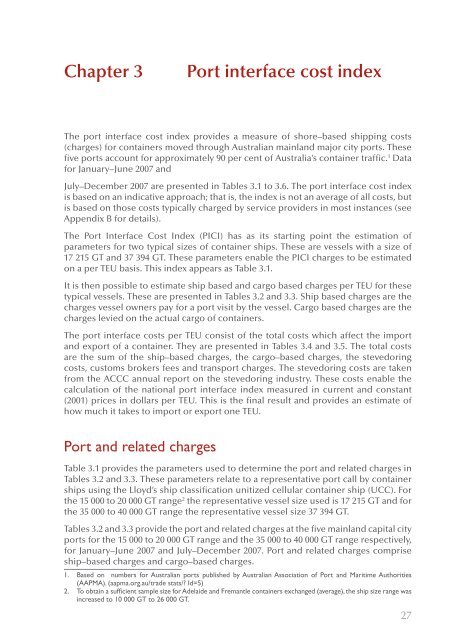PDF: 1352 KB - Bureau of Infrastructure, Transport and Regional ...
PDF: 1352 KB - Bureau of Infrastructure, Transport and Regional ...
PDF: 1352 KB - Bureau of Infrastructure, Transport and Regional ...
- No tags were found...
Create successful ePaper yourself
Turn your PDF publications into a flip-book with our unique Google optimized e-Paper software.
Chapter 3Port interface cost indexThe port interface cost index provides a measure <strong>of</strong> shore–based shipping costs(charges) for containers moved through Australian mainl<strong>and</strong> major city ports. Thesefive ports account for approximately 90 per cent <strong>of</strong> Australia’s container traffic. 1 Datafor January–June 2007 <strong>and</strong>July–December 2007 are presented in Tables 3.1 to 3.6. The port interface cost indexis based on an indicative approach; that is, the index is not an average <strong>of</strong> all costs, butis based on those costs typically charged by service providers in most instances (seeAppendix B for details).The Port Interface Cost Index (PICI) has as its starting point the estimation <strong>of</strong>parameters for two typical sizes <strong>of</strong> container ships. These are vessels with a size <strong>of</strong>17 215 GT <strong>and</strong> 37 394 GT. These parameters enable the PICI charges to be estimatedon a per TEU basis. This index appears as Table 3.1.It is then possible to estimate ship based <strong>and</strong> cargo based charges per TEU for thesetypical vessels. These are presented in Tables 3.2 <strong>and</strong> 3.3. Ship based charges are thecharges vessel owners pay for a port visit by the vessel. Cargo based charges are thecharges levied on the actual cargo <strong>of</strong> containers.The port interface costs per TEU consist <strong>of</strong> the total costs which affect the import<strong>and</strong> export <strong>of</strong> a container. They are presented in Tables 3.4 <strong>and</strong> 3.5. The total costsare the sum <strong>of</strong> the ship–based charges, the cargo–based charges, the stevedoringcosts, customs brokers fees <strong>and</strong> transport charges. The stevedoring costs are takenfrom the ACCC annual report on the stevedoring industry. These costs enable thecalculation <strong>of</strong> the national port interface index measured in current <strong>and</strong> constant(2001) prices in dollars per TEU. This is the final result <strong>and</strong> provides an estimate <strong>of</strong>how much it takes to import or export one TEU.Port <strong>and</strong> related chargesTable 3.1 provides the parameters used to determine the port <strong>and</strong> related charges inTables 3.2 <strong>and</strong> 3.3. These parameters relate to a representative port call by containerships using the Lloyd’s ship classification unitized cellular container ship (UCC). Forthe 15 000 to 20 000 GT range 2 the representative vessel size used is 17 215 GT <strong>and</strong> forthe 35 000 to 40 000 GT range the representative vessel size 37 394 GT.Tables 3.2 <strong>and</strong> 3.3 provide the port <strong>and</strong> related charges at the five mainl<strong>and</strong> capital cityports for the 15 000 to 20 000 GT range <strong>and</strong> the 35 000 to 40 000 GT range respectively,for January–June 2007 <strong>and</strong> July–December 2007. Port <strong>and</strong> related charges compriseship–based charges <strong>and</strong> cargo–based charges.1. Based on numbers for Australian ports published by Australian Association <strong>of</strong> Port <strong>and</strong> Maritime Authorities(AAPMA). (aapma.org.au/trade stats/? Id=5)2. To obtain a sufficient sample size for Adelaide <strong>and</strong> Fremantle containers exchanged (average), the ship size range wasincreased to 10 000 GT to 26 000 GT.27
















